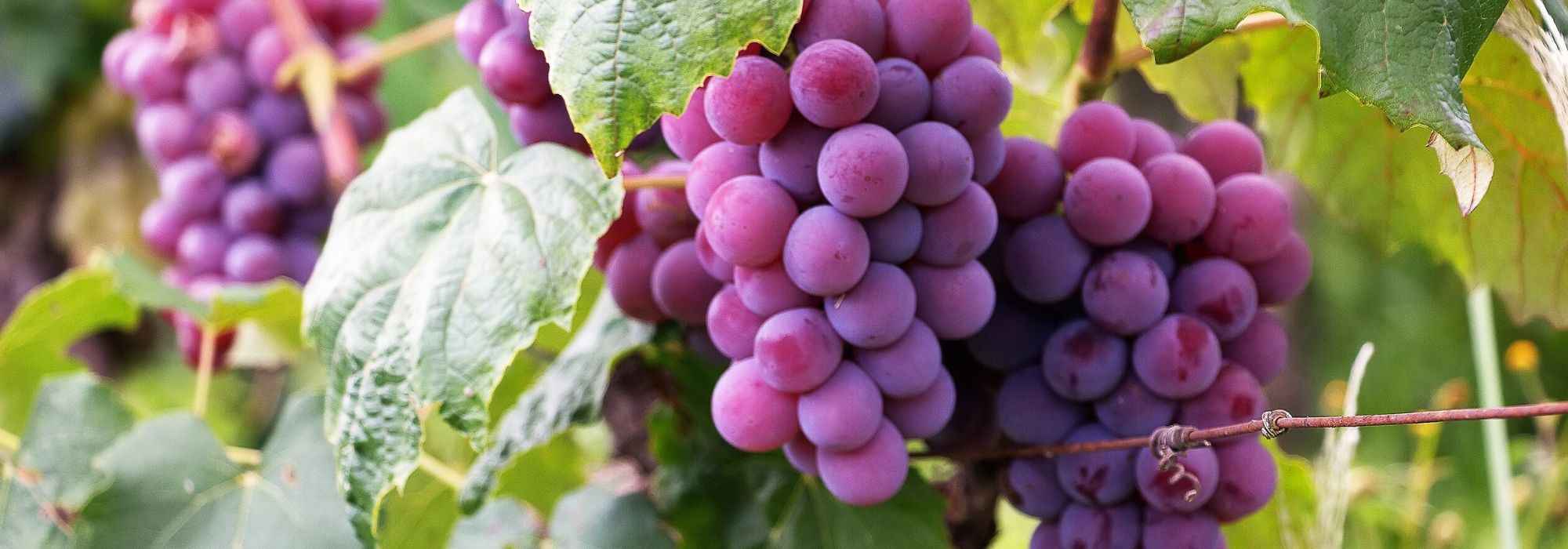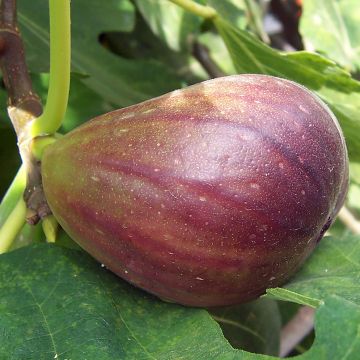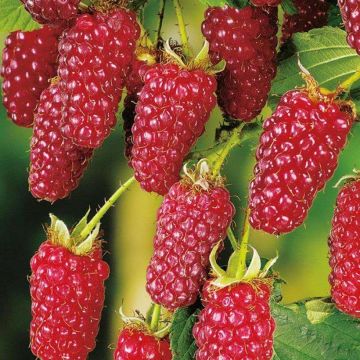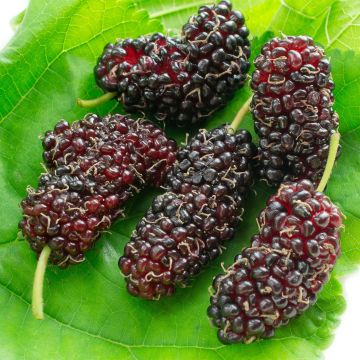

Vitis labrusca x vinifera Fragola Nera Précoce - Dessert Grape
Vitis labrusca x vinifera Fragola Nera Précoce - Dessert Grape
Vitis labrusca x vinifera Fragola Nera Précoce
Fox Grape, Grapevine, Common Grape Vine, European Grape, Wine Grape
This grape is excellent, it has an incredible taste that's nothing like the grapes you find in stores. My vine is now 5 years old and has been producing abundantly for 2 years. I don't use any treatments and it's beautiful. Everyone loves it.
Juanita banana, 23/09/2025
Special offer!
Receive a €20 voucher for any order over €90 (excluding delivery costs, credit notes, and plastic-free options)!
1- Add your favorite plants to your cart.
2- Once you have reached €90, confirm your order (you can even choose the delivery date!).
3- As soon as your order is shipped, you will receive an email containing your voucher code, valid for 3 months (90 days).
Your voucher is unique and can only be used once, for any order with a minimum value of €20, excluding delivery costs.
Can be combined with other current offers, non-divisible and non-refundable.
Home or relay delivery (depending on size and destination)
Schedule delivery date,
and select date in basket
This plant carries a 6 months recovery warranty
More information
We guarantee the quality of our plants for a full growing cycle, and will replace at our expense any plant that fails to recover under normal climatic and planting conditions.

Description
The 'Fragola Nera Precoce' vine is very similar to the 'Fragola Nera', but its fruits reach maturity about two weeks earlier. It is a vigorous, productive, and naturally disease-resistant hybrid variety. This climbing plant produces beautiful clusters of small black grapes with thick skin, and the pulp has an aromatic and fragrant flavour reminiscent of wild strawberries. They can be eaten as they are or used to make juice, giving jams and jellies exotic flavours of lychee or papaya. The harvest takes place, depending on the region, year, and climate, from early September to mid-October. It can be grown in the garden, on a pergola, or a sturdy trellis against a wall.
The 'Fragola Nera Precoce' vine is a horticultural hybrid. One of its parents is Vitis labrusca, a species native to eastern North America that has passed on its natural resistance to phylloxera, a root parasite of European vines. It also inherited the thick skin that covers its grapes and their unique flavour (strong and earthy aromas, known as "foxy"). Its second parent is an unknown variety of Vitis vinifera, cultivated since ancient times in Europe, the Middle East, and North Africa. All vines belong to the Vitaceae family.
Vitis 'Fragola Nera Precoce' is a sarmentous and climbing shrub, with twisting stems equipped with tendrils that can exceed 5 metres in length over time. It forms a trunk, often knotty and twisted, covered with fibrous, brown bark that flakes off in strips as it ages. Its long green stems bear beautiful round, medium green leaves with serrated edges, turning yellow before falling in autumn. It blooms in late spring, from May to June depending on the region, in the form of dense and well-formed, pyramidal to cylindrical clusters, loaded with tiny green to yellowish nectar-rich flowers. After pollination by insects, the grapes are formed. 'Fragola Nera Precoce' produces medium to large, pyramidal and cylindrical clusters, weighing 250 to 400 grams. Its black grapes are small, oval, with thick skin. Their purple, firm, juicy pulp, with few seeds, has a typical wild strawberry flavour. This variety is very hardy and easy to grow in any well-drained garden soil. It is pruned in late winter, after frost, above 3 buds (buds) to promote the formation of new flowering shoots.
Planted in a sunny spot, the 'Fragola Nera Precoce' vine will be very decorative along a wall, on a pergola, in the ground, or in a large container on a terrace. This grape variety is appreciated for its ornamental value in gardens, thanks to its decorative foliage throughout the season. When vinified, its grapes reveal an atypical flavour, somewhat "earthy" (the Anglophones say "foxy"). They can be enjoyed at the table or in numerous recipes.
Vitis labrusca x vinifera Fragola Nera Précoce - Dessert Grape in pictures


Plant habit
Fruit
Flowering
Foliage
Botanical data
Vitis
labrusca x vinifera
Fragola Nera Précoce
Vitaceae
Fox Grape, Grapevine, Common Grape Vine, European Grape, Wine Grape
Cultivar or hybrid
Planting and care
The 'Fragola Nera Precoce' Vine should be planted in ordinary but well-drained soil. If not grafted, it requires neutral or acidic soil (unlike European vines that prefer limestone). If grafted, it can tolerate limestone. Plant it in moist soil that has been enriched with organic fertiliser. Once established, the vine can withstand summer drought fairly well. Choose a sunny location, possibly partial shade in the south (southeast exposure). It can tolerate temperatures as low as -20°C. Prune it in February-March, after the frost, leaving 2 or 3 buds on the secondary branches. Prune it again once the berries have formed on the clusters, leaving 2 or 3 leaves above each cluster (this allows the sun to reach the fruits and the sap to nourish them more effectively). Once the framework of your trellis is formed, remove the branches that have produced fruits each year. Stake or train the branches for support and guidance. Train it against a wall to directly access the grapes. Mildew and powdery mildew are common (especially in rainy climates), so it is necessary to treat the vine as a precaution in spring and during summer, with Bordeaux mixture and/or sulphur powder. This vine may take a season to establish itself properly, during which it will grow moderately. Its woody climbing stems will then grow several metres per year and will require pruning.
Planting period
Intended location
Care
Planting & care advice
-
, onOrder confirmed
Reply from on Promesse de fleurs
Similar products
Haven't found what you were looking for?
Hardiness is the lowest winter temperature a plant can endure without suffering serious damage or even dying. However, hardiness is affected by location (a sheltered area, such as a patio), protection (winter cover) and soil type (hardiness is improved by well-drained soil).

Photo Sharing Terms & Conditions
In order to encourage gardeners to interact and share their experiences, Promesse de fleurs offers various media enabling content to be uploaded onto its Site - in particular via the ‘Photo sharing’ module.
The User agrees to refrain from:
- Posting any content that is illegal, prejudicial, insulting, racist, inciteful to hatred, revisionist, contrary to public decency, that infringes on privacy or on the privacy rights of third parties, in particular the publicity rights of persons and goods, intellectual property rights, or the right to privacy.
- Submitting content on behalf of a third party;
- Impersonate the identity of a third party and/or publish any personal information about a third party;
In general, the User undertakes to refrain from any unethical behaviour.
All Content (in particular text, comments, files, images, photos, videos, creative works, etc.), which may be subject to property or intellectual property rights, image or other private rights, shall remain the property of the User, subject to the limited rights granted by the terms of the licence granted by Promesse de fleurs as stated below. Users are at liberty to publish or not to publish such Content on the Site, notably via the ‘Photo Sharing’ facility, and accept that this Content shall be made public and freely accessible, notably on the Internet.
Users further acknowledge, undertake to have ,and guarantee that they hold all necessary rights and permissions to publish such material on the Site, in particular with regard to the legislation in force pertaining to any privacy, property, intellectual property, image, or contractual rights, or rights of any other nature. By publishing such Content on the Site, Users acknowledge accepting full liability as publishers of the Content within the meaning of the law, and grant Promesse de fleurs, free of charge, an inclusive, worldwide licence for the said Content for the entire duration of its publication, including all reproduction, representation, up/downloading, displaying, performing, transmission, and storage rights.
Users also grant permission for their name to be linked to the Content and accept that this link may not always be made available.
By engaging in posting material, Users consent to their Content becoming automatically accessible on the Internet, in particular on other sites and/or blogs and/or web pages of the Promesse de fleurs site, including in particular social pages and the Promesse de fleurs catalogue.
Users may secure the removal of entrusted content free of charge by issuing a simple request via our contact form.
The flowering period indicated on our website applies to countries and regions located in USDA zone 8 (France, the United Kingdom, Ireland, the Netherlands, etc.)
It will vary according to where you live:
- In zones 9 to 10 (Italy, Spain, Greece, etc.), flowering will occur about 2 to 4 weeks earlier.
- In zones 6 to 7 (Germany, Poland, Slovenia, and lower mountainous regions), flowering will be delayed by 2 to 3 weeks.
- In zone 5 (Central Europe, Scandinavia), blooming will be delayed by 3 to 5 weeks.
In temperate climates, pruning of spring-flowering shrubs (forsythia, spireas, etc.) should be done just after flowering.
Pruning of summer-flowering shrubs (Indian Lilac, Perovskia, etc.) can be done in winter or spring.
In cold regions as well as with frost-sensitive plants, avoid pruning too early when severe frosts may still occur.
The planting period indicated on our website applies to countries and regions located in USDA zone 8 (France, United Kingdom, Ireland, Netherlands).
It will vary according to where you live:
- In Mediterranean zones (Marseille, Madrid, Milan, etc.), autumn and winter are the best planting periods.
- In continental zones (Strasbourg, Munich, Vienna, etc.), delay planting by 2 to 3 weeks in spring and bring it forward by 2 to 4 weeks in autumn.
- In mountainous regions (the Alps, Pyrenees, Carpathians, etc.), it is best to plant in late spring (May-June) or late summer (August-September).
The harvesting period indicated on our website applies to countries and regions in USDA zone 8 (France, England, Ireland, the Netherlands).
In colder areas (Scandinavia, Poland, Austria...) fruit and vegetable harvests are likely to be delayed by 3-4 weeks.
In warmer areas (Italy, Spain, Greece, etc.), harvesting will probably take place earlier, depending on weather conditions.
The sowing periods indicated on our website apply to countries and regions within USDA Zone 8 (France, UK, Ireland, Netherlands).
In colder areas (Scandinavia, Poland, Austria...), delay any outdoor sowing by 3-4 weeks, or sow under glass.
In warmer climes (Italy, Spain, Greece, etc.), bring outdoor sowing forward by a few weeks.

















































